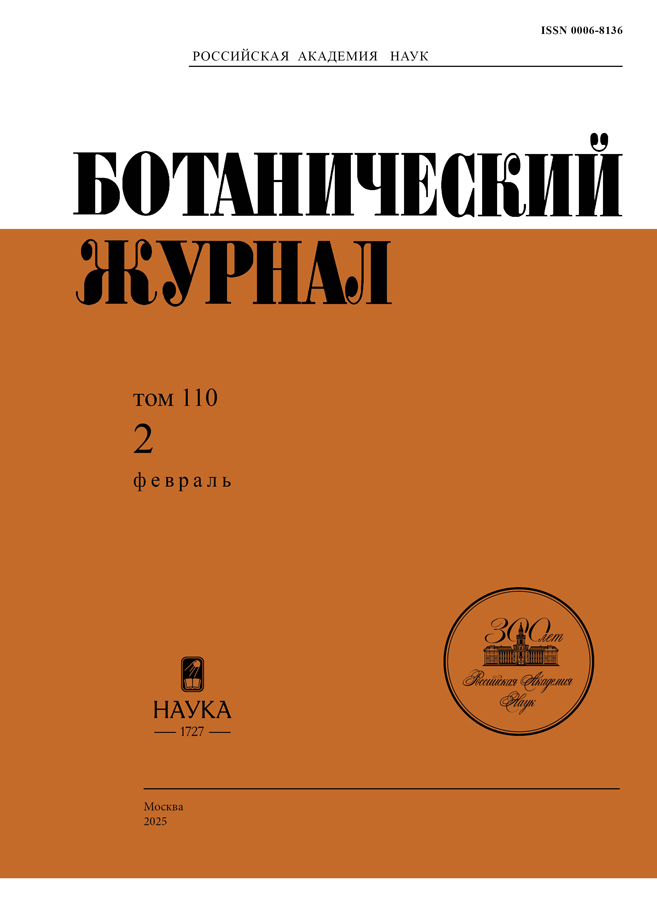Trimonoecy in Galium rivale (Rubiaceae)
- Авторлар: Godin V.N.1
-
Мекемелер:
- Central Siberian Botanical Garden of the Siberian Branch of the Russian Academy of Sciences
- Шығарылым: Том 110, № 2 (2025)
- Беттер: 150-158
- Бөлім: COMMUNICATIONS
- URL: https://rjdentistry.com/0006-8136/article/view/680812
- DOI: https://doi.org/10.31857/S0006813625020037
- EDN: https://elibrary.ru/DNNNAX
- ID: 680812
Дәйексөз келтіру
Аннотация
Trimonoecy has been identified to occur in the perennial polycarpic herbaceous Galium rivale growing in the Moscow Region. Its trimonoecious state is described in detail here for the first time. The studies, performed during 2022–2024, were carried out applying generally accepted methods. Each individual was found to produce three types of flowers: bisexual, staminate, and pistillate. In staminate flowers, styles and stigmas were completely absent, while pistillate flowers lacked an androecium. Bisexual and staminate flowers were generally larger than pistillate flowers. Pollen grain size and pollen fertility did not differ significantly between bisexual and staminate flowers. Bisexual flowers formed on the shoots of the I–VII orders, pistillate flowers on the shoots of the IV–V orders, and staminate flowers on the shoots of the VI–VII orders of branching. In synflorescences, bisexual flowers predominated, representing up to 96% of all flowers, while pistillate and staminate flowers accounted for up to 2–3% and 1–2%, respectively. The few reports of trimonoecy available in the literature are mentioned and discussed here.
Негізгі сөздер
Толық мәтін
Авторлар туралы
V. Godin
Central Siberian Botanical Garden of the Siberian Branch of the Russian Academy of Sciences
Хат алмасуға жауапты Автор.
Email: vn.godin@mpgu.su
Ресей, 101, Zolotodolinskaya St., Novosibirsk, 630090
Әдебиет тізімі
- Bannikova V.A. 1976. Morphology of panicle and peculiarities of flowering of Zizania latifolia (Griseb.) Stapf. – Bot. Zhurn. 61(7): 990–993 (In Russ.).
- Bulokhov A.D., Semenishchenkov Yu.A., Panasenko N.N. 2018. Nitrophilous grassy communities of the class Epilobietea angustifolii Tx. et Preising ex von Rochow 1951 in the Sozh-Desna interfluve. – Vegetation of Russia. 33: 19–40 (In Russ.). https://doi.org/10.31111/vegrus/2018.33.19
- Dempster L.T. 1990. The genus Galium (Rubiaceae) in South America. IV. – Allertonia. 5(3): 283–345.
- Demyanova E.I. 2000. Monoecy. – In: Embryology in flowering plants. Terminology and concepts. Vol. 3. Reproductive systems. Saint-Petersburg. P. 75–78 (In Russ.).
- Demyanova E.I. 2011. The spectrum of sexual types and forms in the local floras of the Urals (Cis- and Trans-Urals). – Bot. Zhurn. 96(10): 1297–1315 (In Russ.).
- Ehrendorfer F., Barfuss M.H.J., Manen J.-F., Schneeweiss G.M. 2018. Phylogeny, character evolution and spatiotemporal diversification of the species-rich and world-wide distributed tribe Rubieae (Rubiaceae). – PLoS ONE. 13(12): e0207615. https://doi.org/10.1371/journal.pone.0207615
- Fedorov Al.A., Artyushenko Z.T. 1975. Organographia illustrata plantarum vascularum. Flos. Leningrad. 351 p. (In Russ.).
- Godin V.N. 2007. Sex differentiation in plants. Terms and notions. – Zhurn. obsh. biol. 68(2): 98–108 (In Russ.).
- Godin V.N. 2022. Trioecy in flowering plants. – Dokl. Biol. Sci. 507(1): 301–311. https://doi.org/10.1134/S0012496622060023
- Godin V.N. 2023. Andromonoecy in Galium odoratum (Rubiaceae). – Bot. Zhurn. 108(9): 821–830 (In Russ.). https://doi.org/10.31857/S0006813623090041
- Godin V.N., Ialamova J.I. 2020. Sexual types of flowers morphology in Heracleum sibiricum (Apiaceae). – BIO Web of Conferences. 24: 00025. https://doi.org/10.1051/bioconf/20202400025
- Goldberg E.E., Otto S.P., Vamosi J.C., Mayrose I., Sabath N., Ming R., Ashman T.-L. 2017. Macroevolutionary synthesis of flowering plant sexual systems. – Evolution. 71(4): 898–912. https://doi.org/10.1111/evo.13181
- Mangla Y., Das K., Bali S., Ambreen H., Raina S., Tandon R., Goel S. 2019. Occurrence of subdioecy and scarcity of gender-specific markers reveal an ongoing transition to dioecy in Himalayan seabuckthorn (Hippophae rhamnoides ssp. turkestanica). – Heredity. 122(1): 120–132. https://doi.org/10.1038/s41437-018-0084-z
- Morozova O.V., Belyaeva N.G., Gnedenko A.E., Suslova E.G., Chernenkova T.V. 2021. Syntaxonomy and ecology of the Moscow Region black alder communities. – Vegetation of Russia. 42: 42–62 (In Russ.). https://doi.org/10.31111/vegrus/2021.42.42
- Parma D.F., Souza K.F., Vaz M.G.M.V., Martins S.B., Araújo W.L., Zsögön A., Weber A.P.M., Schranz M.E., Nunes-Nesi A. 2023. Exploring the diversity of sexual systems and pollination in Brazilian Cleomaceae species. – Flora. 300: 152245. https://doi.org/10.1016/j.flora.2023.152245
- Pobedimova E.G. 1978. Galium L. – In: Flora of the European part of the USSR. Vol. 3. Leningrad. P. 100–115 (In Russ.).
- Robinsohn I. 1924. Die Färbungsreaktion der Narbe, Stigmatochromie, als morpho-biologische Blütenuntersuchungsmethode. – In: Sitzungsberichte der Akademie der Wissenschaften. Mathematisch-naturwissenschaftliche Сlasse. Abt. I. 133(7–8): 181–211.
- Ronse de Craene L.P. 2010. Floral Diagrams. An aid to understanding flower morphology and evolution. Cambridge University Press. 441 p.
- Shirokikh P.S., Martynenko V.B., Baisheva E.Z., Fedorov N.I., Muldashev A.A., Naumova L.G. 2021. Diversity of broad-leaved and pine–broad-leaved forests on the eastern border of their distribution. – Vegetation of Russia. 42: 63–117 (In Russ.). https://doi.org/10.31111/vegrus/2021.42.63
- Sokal R.R., Rohlf F.J. 2012. Biometry: the principles and practice of statistics in biological research. 4th edition. New York. 937 p.
- Soza V.L., Olmstead R.G. 2010. Evolution of breeding systems and fruits in New World Galium and relatives (Rubiaceae). – Amer. J. Bot. 97(10): 1630–1646. https://doi.org/10.3732/ajb.1000130
- Tkachenko K.G. 1989. Features of flowering and seed productivity of some species of Heracleum L. grown in the Leningrad region. – Rastitelnye resursy. 25(1): 52–61 (In Russ.).
- Troll W. 1969 Die Infloreszenzen: Typologie und Stellung im Aufbau des Vegetationskörpers. Bd. II. Jena. 630 S.
- Weberling F., Troll W. 1998. Die Infloreszenzen: Typologie und Stellung im Aufbau des Vegetationskörpers. B. II. T. 2. Jena. 483 S.
- Zhivotovskii L.A. 1979. Indicator of similarity of populations by polymorphic traits. – Zhurn. Obshchey biologii. 40(4): 587–602 (In Russ.).
Қосымша файлдар










